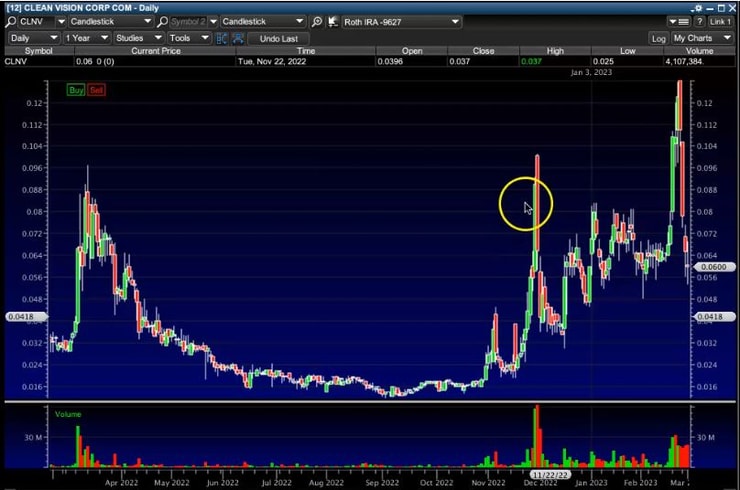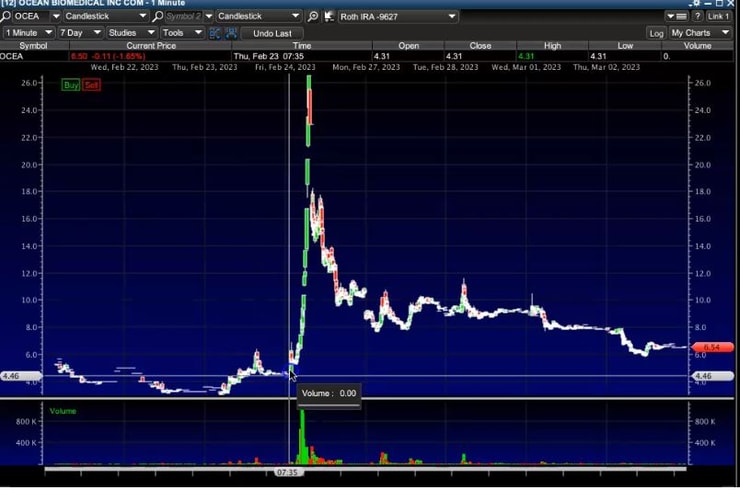Making money in the stock market is the hardest way to make an easy buck.
Most people who get into trading hear about the success stories but fail to understand it takes A LONG time to develop the skills and mindset of a profitable trader.
There are no shortcuts…
To get results, you must put in the work.
Market dynamics change quickly. That’s why studying daily is so important.
I just wrapped up my February review and discovered six essential lessons for you to take into the month of March.
This game is all about adapting.
Here are my six big takeaways from last month…
Table of Contents
Lesson #1: Not Every Play Is A Dip-Buy Opportunity

Penny stock trading requires you to be patient.
A strategy that I’ve been leaning on a lot lately has been the “panic dip-buy”
It’s where I buy a stock that’s had a recent catalyst and selling off hard.
You see, most penny stock promotions are done for one main purpose. And that’s for the company to raise money. So they’ll pump the stock by issuing press releases. If the pump works, the stock will go up, and then they’ll raise money. After they raise money, the stock usually dumps, and then the cycle repeats again later on.
That’s why I don’t mind buying these stocks getting pumped off dips because my experience tells me that they fire off more press releases until they get their financing.
But once they’ve got their financing, I’m not interested in the “panic dip buy.”
I know, it’s a dirty game. And a lot of these companies are run by scum. But I don’t make the rules. I always tell my students to expect the worst from these companies.
I trade penny stocks because I believe they follow predictable patterns. And if you study their behavior over time, I think you can pick up on them too.
But just because a stock is selling-off hard…doesn’t mean it’s a buy.
Just take a look at yesterday’s price action in the ticker symbol SI:
Glad I made this video premarket when $SI was down “only” 30% warning that it could go much lower. Now it’s down 55% on the day & all aggressive dip buyers have been crushed. It pays to know the https://t.co/46W8tDB2QL setup when to dip buy/when not to, study @completepenny asap! pic.twitter.com/ZRjwiHJFlG
— Timothy Sykes (@timothysykes) March 2, 2023
Lesson #2 Be Conservative…But Stay Opportunistic
2023 thus far has been a slow year for trading. That doesn’t mean things can’t heat up, but it hasn’t happened yet.
I’ve done an excellent job at keeping my losses small. And I’ve tried my best to focus on the patterns and catalysts I’ve seen working.
Luckily my hectic travel schedule has taken me away from my computer screen.

Staying disciplined is difficult if you watch the markets on your computer all day.
I’m even vulnerable to overtrading if I have too much screen time.
In a slower market, you’ve got to fight off the temptation of chasing moves. I haven’t seen a lot of follow-throughs on one-day runners. That’s why it’s okay if you miss a move because you’ll likely get a chance to enter if you stay patient.
The lack of follow-throughs makes me want to take profits faster. Many newbie traders get greedy when they’ve got a winning trade on their hands. But I’ve seen a lot of large spikers fade.
More Breaking News
- Opendoor Technologies’ CEO Stock Sale Sparks Speculation Amid Stock Volatility
- Tesla Stock Faces Question Marks: What Recent News Clarifies?
- Quantum Corporation’s Leap Forward: What Now for Investors?
This is not the market for greedy traders.
Lesson #3: Singles Add Up

It was a pretty brutal month for stocks in February, but I still managed to make over $10,000.
I didn’t have any monster trades. But I kept my losses small, and my winners were larger than my losers.
Small wins can stack up if you manage risk properly.
Some traders have goals to make $500 to $1,000 a day.
But guess what?
The market doesn’t care about your goals.
That’s why it’s better to focus on developing your skills and refining your process. And when the market heats up again, you’ll be prepared to take advantage of it.
Don’t get hung up on monetary goals.
Lesson #4: Short-Selling Is A Dangerous Game
We see huge spikes like the one in the ticker symbol OCEA because short-sellers get aggressive and cause squeezes.
Now, you might be thinking: Tim, didn’t you tell me earlier to expect the worst from these companies?
It’s true.
But you really need DEEP POCKETS if you want to be a successful short-seller. I agree that many large spikers will eventually come back down. But that doesn’t mean they can’t squeeze for several days before they come crashing down.
The old adage is true: The markets can stay irrational longer than you can stay solvent.
Don’t believe the hype you see on social media from short-sellers. They never post their losses. The name of the game is to live to fight another day. If you get caught on the wrong side of the short, it could be game over for you.
Lesson #5: Focus On Yourself

Don’t believe the hype you see on social media, traders flashing their big wins, making it look easy.
Do these clowns ever post their losses?
Don’t get sucked into the idea all you have to do is follow an alert-service and you’ll instantly be profitable.
You’ve got to discover what works best for YOU.
Don’t get discouraged if you’re not profitable yet. My two most profitable students didn’t make money their first year. In fact, combined, they lost money in year one. And these are two guys who have both made 8 figures in their trading careers.
Focus on getting better every day. Focus on yourself.
Lesson #6: Learn From Your Trading & Adapt

At the end of the day, you want to discover what your strengths and weaknesses are. Once you can do that, work on doubling down on your strengths.
The only way you can do that is by studying and reviewing your trades daily. In addition, you want to study trades that you’ve missed, figure out why you missed them, and how you can prepare to take advantage of them next time.
Pay attention to the overall market. It will tell you when it’s time to get aggressive and when to be conservative.
Most importantly, focus on learning and developing your process.



Leave a reply